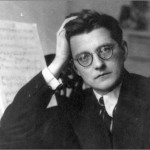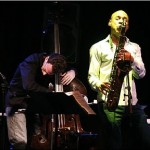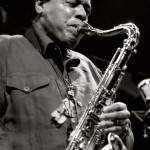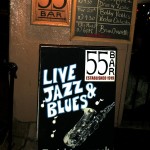In December of 2004, an unusually deranged heavy metal fan leapt up onstage during a Damageplan concert in Columbus, Ohio and shot to death 38-year-old ex-Pantera guitarist “Dimebag” Darrell Abbott.
Less than a year later, guitarist Denis “Piggy” D’Amour, of the Canadian art/thrash/what-have-you band Voivod, died of cancer. He was 45.
It was a one-two, jab-hook combination against metal guitar, and from what I can tell, the genre is still down for the count.
I guess they were influential, these two D.D.’s, though inspirational is maybe a better term. In a genre cluttered with cookiecutter speedfreaks and Malmsteen wannabes, Dimebag and Piggy were nothing of the sort. If nobody really followed them, maybe that’s because following them would have been suicidal—the proverbial empty elevator shaft Dizzy Gillespie once identified with following Monk.
They couldn’t have been more different from each other. Thin and fat. Scorchin’ Texas and frozen Quebec. Good ol’ boy and techno death-geek. Dimebag, joker, all heart gut & balls, ever-busy making a spectacle of himself; Piggy, soft-spoken, deliberate in approach, and always pushing a lot of brain (okay, I lifted that phrase from an old Maximum Rock n Roll).
They did have one thing in common: both claimed to lack formal instruction. Maybe it was partly this that enabled them to re-imagine the boundaries of metal guitar in the late ‘80s and early ‘90s, to push an already marginally tonal genre to extremes of artful dissonance and sheer noise. In this respect, the difference between Piggy and Dimebag is something like the difference in twentieth-century classical between modernism and the postwar avant-garde. Piggy was the Schoenberg figure here, or at least the Bartok; Dimebag was Steve Reich, or Pierre Boulez.
Holy shit that’s pretentious. Okay, you’re over it now.
***
 Dimebag had to go out a rock star. It was the way he came into the world. What the actor Tom Towles once said about himself applies to Dimebag as well: he was unsuited to regular employment. Only a lifelong fan of the genre could have played the guitar the way Dimebag did. (Actually, that’s not a bad definition of metal. Forget all that shit about power chords and operatic vocals; metal is the genre in which the deified performer is but the apotheosis of the fan.) Watching Dimebag was like watching a dog chase a frisbee, and then chew on it. He played his guitar in the same spirit that Kiss painted their faces—and, good exhibitionist that he was, he was never averse to painting his own in the pre- (lead singer Phil) Anselmo years of Pantera, when the band looked a like a southern-fried Mötley Crüe. He was clown and wizard, a cross between Eddie Van Halen and Ace Frehley. He was a first-class snakeoil peddlar, too, and the music, the solos in particular, were always part salespitch and part magic show. He worked with a fairly restricted harmonic palette, but a seemingly endless range of timbres, the more abrasive the better. And he made an absolute virtue out of his obnoxiousness.
Dimebag had to go out a rock star. It was the way he came into the world. What the actor Tom Towles once said about himself applies to Dimebag as well: he was unsuited to regular employment. Only a lifelong fan of the genre could have played the guitar the way Dimebag did. (Actually, that’s not a bad definition of metal. Forget all that shit about power chords and operatic vocals; metal is the genre in which the deified performer is but the apotheosis of the fan.) Watching Dimebag was like watching a dog chase a frisbee, and then chew on it. He played his guitar in the same spirit that Kiss painted their faces—and, good exhibitionist that he was, he was never averse to painting his own in the pre- (lead singer Phil) Anselmo years of Pantera, when the band looked a like a southern-fried Mötley Crüe. He was clown and wizard, a cross between Eddie Van Halen and Ace Frehley. He was a first-class snakeoil peddlar, too, and the music, the solos in particular, were always part salespitch and part magic show. He worked with a fairly restricted harmonic palette, but a seemingly endless range of timbres, the more abrasive the better. And he made an absolute virtue out of his obnoxiousness.
For Dimebag, there was nothing metaphorical about the guitar’s phallicism: it was a penis, and every solo a masturbatory epic. Here is what Sartre said about Jean Genet: “He jerks off the universe.” Not a bad line to describe Dimebag. (Yeah, I know: not a bad line period.) Like Genet’s sainted murderers, the guitar was bride as much as phallus; one got the impression that he took the instrument to bed with him, as legend has it Hendrix did. Perhaps one has to marry one’s own penis to be a great guitarist in the mold of Dimebag. And yet, if Dimebag was the most masturbatory of players—and in a genre as masturbatory as metal, that’s saying quite a lot—it was masturbation without ritual; it was pure play, as if he had just discovered pleasure and was indulging himself for the first time.
Because the guitar was an extension of his body, one couldn’t imagine Dimebag thinking before the note. Of course he did think, was a very conscious player; but the way he approached the instrument convinced us he didn’t, that the music just came out of his pores. Maybe that’s why, even at its most outlandish and distorted, Dimebag’s playing retains an organic fluidity and warmth. And then the guitar was so much his center of gravity that he looked ridiculous without it, all hunched and gangly, with too-big feet and hands. (I took my partner to see Nancy Griffith a couple of years ago, and it was the same thing with her (Griffith, I mean): she looked ridiculous without her guitar. Except that, in her case, wearing those metal fingerpicks, she reminded me of Max Schreck in Nosferatu.)
*
Pantera may have started the Anselmo years with something of a “nu metal” vibe, fusing southern rock and funk/rap to classic metal on Cowboys From Hell and Vulgar Display of Power. (I’m ignoring Power Metal here, and I hope you will, too.) But by their third album, they weren’t pushing other genres on metal, but metal itself, the metal they had made, out from the inside, trying to punch a hole in it, or crash land it somewhere. It’s as if the band had made a bet after Cowboys as to how long it would take them to pulverize the genre into noise. “You can free yourself,” Dio once sang, “but the only way to go is down,” and with The Great Southern Trendkill, Pantera hit bottom, the primordial metal mud: the album was even more “abrasive, oppressive, and hard to listen to” than Anselmo had promised Far Beyond Driven would be. Not for nothing Anselmo’s post-Pantera effort is named Down, and not just for being south (of heaven?). Nor is it surprising that Pantera would come back together for only one more great, underrated, and in many respects more traditional album, Reinventing the Steel, before disbanding for good.
 Compare, for example, the seminal power ballad “Cemetery Gates” (on Cowboys) to “Suicide Note” (Parts I and II), or “10s,” or “Floods” (all on Trendkill). “Cemetery Gates” is firmly in the melodic-operatic mode; at the song’s climax, Dimebag and Anselmo go toe-to-toe, the guitar matching higher and higher cries of the word “gates,” until the guitar replaces the voice with a note that Anselmo’s falsetto can’t reach, and then careens down and crashes as the song fades out. This was back before the drugs or whatever had trashed Anselmo’s voice; on some tracks he sounds uncannily like a young Rob Halford (of Judas Priest, damn you). But if one can’t imagine Pantera doing a “Cemetery Gates” by the time they get to Trendkill, it’s not just because Anselmo couldn’t sing it anymore. Their whole ethos had shifted. They try for “Cemetery,” but end up with “Suicide Note, Part I,” which always struck me as the most sarcastic of metal ballads—the major key, the grotesquely pleading vocals; it feels like a sucker punch for the shrieking violence of “Part II.” As for the other late slow songs, they can no longer properly be called ballads. “Cemetery Gates” was a dirge, a power ballad with a necrophilic tinge. But songs like “10’s” and “Floods” literalize the cemetery feel; they’re sludgy, limp, crawl along leglessly, carrying more than a whiff of the charnel-house about them. All the romance of “Cemetery”—the afterimage of the dead beloved—has been drained out. They are embalmed ballads; you listen to them and think, This is what it feels like to fuck a corpse.
Compare, for example, the seminal power ballad “Cemetery Gates” (on Cowboys) to “Suicide Note” (Parts I and II), or “10s,” or “Floods” (all on Trendkill). “Cemetery Gates” is firmly in the melodic-operatic mode; at the song’s climax, Dimebag and Anselmo go toe-to-toe, the guitar matching higher and higher cries of the word “gates,” until the guitar replaces the voice with a note that Anselmo’s falsetto can’t reach, and then careens down and crashes as the song fades out. This was back before the drugs or whatever had trashed Anselmo’s voice; on some tracks he sounds uncannily like a young Rob Halford (of Judas Priest, damn you). But if one can’t imagine Pantera doing a “Cemetery Gates” by the time they get to Trendkill, it’s not just because Anselmo couldn’t sing it anymore. Their whole ethos had shifted. They try for “Cemetery,” but end up with “Suicide Note, Part I,” which always struck me as the most sarcastic of metal ballads—the major key, the grotesquely pleading vocals; it feels like a sucker punch for the shrieking violence of “Part II.” As for the other late slow songs, they can no longer properly be called ballads. “Cemetery Gates” was a dirge, a power ballad with a necrophilic tinge. But songs like “10’s” and “Floods” literalize the cemetery feel; they’re sludgy, limp, crawl along leglessly, carrying more than a whiff of the charnel-house about them. All the romance of “Cemetery”—the afterimage of the dead beloved—has been drained out. They are embalmed ballads; you listen to them and think, This is what it feels like to fuck a corpse.
“Walk” (on Vulgar) and “Drag the Waters” (on Trendkill) also make an illuminating pair. Based on a similar riff, the change in rhythm, timbre, and arrangement creates two songs as different in feel as Hendrix’s “Who Knows” and “Machine Gun” (on Band of Gypsys, also based around the same riff). “Walk” is all funky syncopation, and the voice and lyrics are stuffed-crotch bravado; but “Waters” is grating and seedy, a rotting wharf of a song, bottomlessly vile. If we thought “Walk” was idle threat, “Waters” cashes in on it, bite to “Walk”’s bark.
Dimebag had everything to do with this relentlessly downward trajectory. Over the course of those first four albums his riffs became more minimal, his sound more dependent on noise and texture, his solos more spare, bend-heavy, and effects-laden, the musical equivalent of the grating screams of Anselmo’s trashed throat and the nihilism of the lyrics. While it’s true that one can find elements of later Pantera as early as Cowboys (on songs like “Primal Concrete Sledge” and the end of “Domination”; in the solo on “Psycho Holiday” or “The Art of Shredding”; even in the discreet false harmonics used to ornament the choruses of “Cemetery”), much of that album remains in a firmly thrash metal/southern rock mold (“Shattered” is a good example, as are “The Sleep” and the title track). Slowly, the oppressiveness builds outward: into the bridge of “This Love” and the outro of “By Demons Be Driven,” the overall sound and feel of “Live in a Hole,” the solo on “Rise,” and the distorted roar of “F*cking Hostile” (all on Vulgar). But none of these could really prepare us for the assaults on metal decency of “Use My Third Arm,” or “Throes of Rejection,” or “Good Friends and a Bottle of Pills,” or “Becoming” (all on Driven): the I-can’t-start-my-tractor sound Meshuggah would perfect on their later albums; the diligently massacred production, in which Darrell’s brother/drummer Vinnie participated, beginning with Vulgar; the songs and solos where melody and riffage alike are submerged under cascades of bends, wah, overdrive, whammy, false harmonics, and flange.
Dimebag could find extremities of pitch and timbre, not just that no one had ever heard before, but that no one imagined anyone would ever want to hear. I can see him dumping effects out of a box like they’re Legos, and building sounds and whole songs from them in much the same way. He could always find something to make his guitar sound messier, or heavier, or more grating (check out “Use My Third Arm”). As the band’s sound grew more pared-back and minimal, Dimebag became more a texture, an aura. On some songs on Trendkill, there is hardly any harmonic foundation left to solo over; the leads rise up like the cries of burning victims from a bombed-out musical landscape … and that’s when he bothered to solo at all (the number of solos had shrunk from all but one song on the first two albums to just over half on Trendkill). Already on Vulgar he had begun to move away from the gorgeously melodic and showy classic metal solos of Cowboys, like the one on “Cemetery Gates” and the song-closer on “Shattered.” The sixteen-beat-long bend that devolves into a whammy flying saucer on “Regular People (Conceit)” and the wah-seizure on “F*cking Hostile” are prototypes for the solos of “I’m Broken,” and “Throes of Rejection,” and “Suicide Note (Part II),” and “The Underground in America”: effect becomes a structuring element rather than ornament or climax, as it was on, say, “Rise.” (A good comparison would be to Tom Morello of Rage Against the Machine, Pantera’s sort of alter-ego in the blending of funk/rap and metal.) But Dimebag could be intensely lyrical and bluesy on those later solos, too: the raunchy Skynardisms of “The Great Southern Trendkill”; the beautiful, lengthy lament on “Floods.” It’s as if, as the music grew more pared back, the solos became the one place where he could still fully exercise his melodic imagination. It was something he never lost—melody, a certain playfulness—no matter how brutish and nasty Pantera got.
What Pantera showed—better, I think, than any other metal band ever would—was that the genre could always be pushed further, that all superlatives are temporary—that, in fact, the band would have to keep outdoing itself if they planned to stay at the vanguard of the genre’s evolution—if, that is, they planned to keep marketing themselves as the world’s most something-or-other metal band—and what is metal without being the most something-or-other at something? Death metal bands would always play faster, doom bands slower, Norwegian black metal bands would always be evil-er, etc.; but I don’t think any of them came close to doing what Pantera did in terms of disintegrating metal riffage into dagger-thrusts of noise. It’s a tribute to them that they never fit comfortably into any of those subgeneric niches … and even more, that they did what they did (at least seemingly) without alienating their more classic and pop-metal audience. I imagine they succeeded because they never entirely lost those elements of southern rock, funk, and rap that had made their early albums so popular. They were also damn good at marketing noise, anger and nihilism as a sort of New Populism.
***
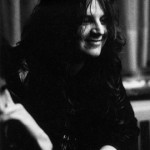 Killing Technology (1987), Voivod’s third album and the first on which they could be said to have found their voice, suggested that the band might be involved in a genre-pulverizing project similar to Pantera’s. Here, the idée fixe was the flatted fifth. For a metal band, this was nothing if not traditional: the association between tritone and devil, the diabolus in musica; its presence in the very three-note riff that inaugurated the genre (Black Sabbath’s “Black Sabbath”). At least since hardcore forced metal to look in the mirror of its own corniness and find its inner motherfucker, the genre has been invested in pushing dissonance in the direction of atonality. Piggy just broke down the door Sabbath had cracked, a door nobody until him had really thought to try. Unlike Pantera, though, by the time of 1989’s Nothingface Voivod was working hard to meld their distinctly outré sound with an alt-pop melodicism—a project which came to fruition on Angel Rat and Outer Limits (albums 6 and 7, respectively), although with varying degrees of success.
Killing Technology (1987), Voivod’s third album and the first on which they could be said to have found their voice, suggested that the band might be involved in a genre-pulverizing project similar to Pantera’s. Here, the idée fixe was the flatted fifth. For a metal band, this was nothing if not traditional: the association between tritone and devil, the diabolus in musica; its presence in the very three-note riff that inaugurated the genre (Black Sabbath’s “Black Sabbath”). At least since hardcore forced metal to look in the mirror of its own corniness and find its inner motherfucker, the genre has been invested in pushing dissonance in the direction of atonality. Piggy just broke down the door Sabbath had cracked, a door nobody until him had really thought to try. Unlike Pantera, though, by the time of 1989’s Nothingface Voivod was working hard to meld their distinctly outré sound with an alt-pop melodicism—a project which came to fruition on Angel Rat and Outer Limits (albums 6 and 7, respectively), although with varying degrees of success.
One can’t claim Piggy was devoid of spectacle, though Voivod had outgrown the outsized trappings of a black metal band after their first couple of albums, even as they retained their custom jagged-cut axes beyond the leather and spikes. On stage, Piggy did his fair share of thrashing, both feet firmly planted, occasionally scooting left or right while bassist Jean-Yves Theriault (“Blacky”) or vocalist Denis Belanger (“Snake”) weaved around him. He smiled a lot, too—not the “yes, I know I’m kicking your ass” smile of most metal musicians, and certainly not a smile one associates with black metal (!). This was an open, boyish smile, as unguarded as Dimebag’s sound.
That said, Piggy was metal’s most bizarre, cerebral guitarist. As with Dimebag, one can hear traces of his style from the beginning: in the bridge of “Black City” and the finale of “Warriors of Ice” (on the brilliant debut War and Pain), when the midrange drops out and raw guitar and bass begin to wend their way apart and together through the mix; in those high, bright chords used to punctuate the musical phrases on “Ice” and “Iron Gang”; and above all, in structuring the intro to “Horror” (from the enthusiastically-titled RRROOOAAARRR) around a diminished arpeggio. These three elements would evolve together and coalesce to become the essence of Voivod’s sound, which was really Piggy’s sound. You could separate Dimebag from Pantera and still have a great metal guitarist in some other band; but if you took Piggy out of Voivod and put him somewhere else, you would still have … Voivod.
By Technology, that damned flatted fifth, a tweaked power chord on a re-tuned instrument, was being employed so ubiquitously (if ubiquity has degrees) that after a while the music stopped sounding dissonant: Piggy convinces us the guitar was supposed to sound that way. The grating diminished chord progressions on the verses and choruses of the title track; the flagrant abuse of the same all over “Tornado”; the burning-carousel finale of “This Is Not An Exercise”: these are songs that seem to move in the interstices of tonalities, a space that Voivod would come to inhabit: an inter-space … a Canadian space, perhaps?
To this first, harmonic innovation Piggy added a second, in pitch, opening the upper registers of the guitar to the song as a whole: those high, bright chords cease to be used merely for exclamation, and instead become a building block of the band’s songwriting. The space above the twelfth fret was a sort of thrash metal no-man’s-land; if guitarists crossed it, it was only to solo or play a harmonized lead. Without those deep power chords, the heaviness of the music was compromised. In fact, by the early ‘90s it had become standard practice to tune guitars down—Dimebag sure as hell did—and singers’ one-time falsetto screams were replaced by menacing growls. (I’ve often wondered to what extent the explosion of bass-oriented music like hip hop influenced metal’s ‘90s propensity to de-tune. I should also note in passing that Piggy’s propensity to use higher-pitched chords betrays a strong punk influence, as do drummer Michel Langevin’s (“Away”) beats.) With Voivod, it was as if the guitarist had been freed to solo for the entire song; sometimes a Voivod song can sound like a single long chordal lead.
Finally, Piggy’s freedom to fiddle with the skinny frets is partly attributable to Blacky’s filling the low end with distorted, orchestral-sounding double-stops. The gap between them actually magnifies both ends of the spectrum of pitch: the heaviness of Blacky’s bass on the one hand, the metallic stridency of Piggy’s guitar on the other. (A similar thing happens with Pantera’s solo sections, beginning with a few songs on Vulgar, and then spreading to the later albums as a whole. It’s a sound Metallica might have learned something from, given the layered turgidity that besludges much of their later music. Is it any wonder that, after spending a decade buried under congealed Hetfieldisms, bassist Jason Newsted would leave Metallica to reform Voivod in 2002? It was surely his greatest career move since founding Flotsam and Jetsam.) The contrapuntal feel that ends “Black City” would find its apotheosis on songs like “X-Ray Mirror” and “Inner Combustion” and “Sub-Effect” on Nothingface. One can’t help but think of the band’s fascination with insects: here is a wasp-waisted band if ever there was one; their sound is all head and abdomen.
It was but a stone’s throw from Technology to Dimension Hatröss (1988) and Nothingface (1989); but what a throw, each album exploiting yet more fully and originally the elements of the Voivod sound. “Experiment,” Hatröss’s overture, rewrites Technology’s “Overreaction” to punctuate each line of verse with four high chordal stabs, and then feeds from a weirdly syncopated 6:8 bridge into a jazzy, cruising chord progression … which, after passing through the odd-time intro section again, returns in terrifying variation—those flatted fifths, replacing the jazzy ninths!—over a pounding orchestral backdrop. The lead feeds naturally into a solo, and then into the song’s finale: an eerie, powertool sound pinched from the very top of the neck. “Die-men-sion … Hay-tross,” vocalist Snake (Denis Belanger) nasally intones: the protagonist of this fully-fledged concept album has arrived, and with it the band’s sound in its purest crystalline form.
“Experiment” is overture in that it encapsulates everything that follows, sonically if not thematically: the obscenely dissonant intro to “Chaosmongers,” and the bridge, where the guitar sounds like an overdriven Theremin; the dancey Lydian melody of “Brain Scan”; the alternating shriek and thunder that presages “Psychic Vacuum.” Although the slant toward pop melodicism and funkier rhythms can begin to be heard here—as well as a tendency to proggier dynamics and more fractured song structures—Nothingface continues the evolution of the aforementioned elements as well, outdoing Hatröss in almost every respect: the dissonance of “Pre-Ignition,” the ethery chord progressions on “Inner Combustion,” the jagged counterpoint of “X-Ray Mirror,” the shimmering jazzinness of the bridge of “Sub-Effect,” with its brilliantly dark variation on the main theme at its conclusion. This evolution would continue, in a somewhat more traditional direction, true, but always with the same attention to dissonance, effect, and tone color, through 1993’s The Outer Limits, the last album until Newsted featuring three of the four founding members.
 Part of the brilliance of Piggy’s playing arises from the contrast between his chordal leads and his traditionally minor pentatonic (blues/rock) solos. I mentioned in a previous post that rock solos tend to be overschematized as moments of liberation from the lockstep ostinato of a typical riff-based song. With Piggy, this schema acquires a new, harmonic meaning: the listener is momentarily released from the treacherous dissonance of verse/chorus, into a solo that sounds more AC/DC than avant-thrash. In this respect, the solos are never the focal point of a Voivod song; they’re moments for us to catch our breath before plunging back into the sonic maelstrom. For all the joy of Piggy’s blues outbursts, he was always more himself (more original, certainly more interesting) in the verses and choruses. If I were less charitable, I would say that only with something so straightforward could Piggy hope to navigate the bizarre harmonic waters of the surrounding song. Musically, though, it might be said that Piggy just exploits the Janus-like nature of the flatted fifth: between diabolus in musica and the blue note, the devil and the deep blue sea.
Part of the brilliance of Piggy’s playing arises from the contrast between his chordal leads and his traditionally minor pentatonic (blues/rock) solos. I mentioned in a previous post that rock solos tend to be overschematized as moments of liberation from the lockstep ostinato of a typical riff-based song. With Piggy, this schema acquires a new, harmonic meaning: the listener is momentarily released from the treacherous dissonance of verse/chorus, into a solo that sounds more AC/DC than avant-thrash. In this respect, the solos are never the focal point of a Voivod song; they’re moments for us to catch our breath before plunging back into the sonic maelstrom. For all the joy of Piggy’s blues outbursts, he was always more himself (more original, certainly more interesting) in the verses and choruses. If I were less charitable, I would say that only with something so straightforward could Piggy hope to navigate the bizarre harmonic waters of the surrounding song. Musically, though, it might be said that Piggy just exploits the Janus-like nature of the flatted fifth: between diabolus in musica and the blue note, the devil and the deep blue sea.
If it’s in that jagged, angular sound that Piggy is most at home, a sound that is all edges and no middle, a sound sometimes more like a mechanized assembly line than a guitar, it’s also a sound that sometimes finds a surprising warmth—and not (just) on those blues solos. I always think of the end of “Pre-Ignition” in this regard. The song could serve as a microcosm of band’s entire project, sonically and conceptually. It’s a monument to dissonance, particularly the bridge, following the line “un-in-ten-tion-al split” (Snake always disassembled words in this way, like some weird language-processing machine). The song begins by taunting the “cy-ber-ne-tic beings” that work in a mine; at the end, “some are set free; / Emotion floods their gaze.” It’s a remarkable moment, this sudden transition from mechanical to human, one for which the band’s sound is perfectly suited; and all of it, it seems, is taken up in Piggy’s guitar, and in that beautiful, multilayered chord that ends the song. Throughout his career, despite the fascination with grating dissonance and the band’s fascination with technology, Piggy’s playing was anything but cheerlessly mechanical. The playfulness of “Cockroaches,” undercutting the fittingly apocalyptic end of Killing Technology; the lobotomized waltz of “Brain Scan”: there were a lot of good reasons for that smile. And if Voivod never made it as a ‘90s alt-pop band, maybe that’s because their sense of humor, as much as their sense of melody, was just a bit too bizarre and introspective to find an audience. Meanwhile, when they tried for nostalgia or teen angst, they ended up with weird hybrids like “Into My Hypercube” (the title says it all). They went from having Soundgarden and Faith No More open for them in ’89 to the Spinal Tap “where are they now?” phase in a few short years. It was partly what happened to thrash metal as a whole, of course—only unkillable Slayer, a limping Anthrax, and something that sounded suspiciously like Metallica made it out alive.
***
If there were something equivalent to the digital photo slideshow for music—but something accessible to a technophobe like me—I’d put together a sort of musical slideshow for each of them, with DJ fades and crossovers between riffs, solos, and sounds, to match the snazzy dissolves and wipes available on photo software.
I wonder what was played at their funerals; I wonder if either of them left instructions, or made a passing comment: bury me to X. Now, had I been anointed to choose the music for either man’s funeral …
Such morbid fantasies!


